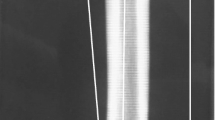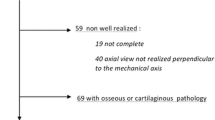Abstract
The purpose of this study was to reveal the association whether the distal morphometry of femur had a relation with femur height or width. Sixty-six adult (35 right and 31 left) dry femurs from Caucasians were used in this study. Computed tomography (CT) imaging was applied to obtain measurement values of the femur. Femur height (413.29 ± 28.40 mm) and width (29.86 ± 2.72 mm) were all checked one by one to determine the correlation with the parameters obtained. Both values exposed high rates of correlation with height (26 ± 2.34 mm) and width (20.85 ± 2.76 mm) of femur notch; also, measures of epicondylar, bicondylar and condylar diameters of femur were obtained. Measures were checked if there was a correlation with femur height and width. Differences displayed in distal morphometry of femur according to race and sex are due to other morphometric measures of femur rather than race and sex. We believe that displaying the high rates of correlation of distal morphometry of femur with femur height and width will be the factor which determines the selection and production of prosthesis among the long or short individuals of folks.



Similar content being viewed by others
References
Anderson AF, Lipscomb AB, Liudahl KJ et al (1987) Analysis of the intercondylar notch by computed tomography. Am J Sports Med 15:547–552
Anderson AF, Dome DC, Gautam S et al (2001) Correlation of anthropometric measurements, strength, anterior cruciate ligament size, and intercondylar notch characteristics to sex differences in anterior cruciate ligament tear rates. Am J Sports Med 29:58–66
Arima J, Whiteside L, McCarthy D et al (1995) Femoral rotational alignment based on the anteroposterior axis, in total knee arthroplasty in a valgus knee: a technical note. J Bone Joint Surg Am 77:1331
Berger R, Rubash H, Seel J et al (1992) Determining the rotational alignment of the femoral component in total knee arthroplasty using the epicondylar axis. Clin Orthop 286:40
Cheng FB, Ji XF, Lai Y et al (2009) Three dimensional morphometry of the knee to design the total knee arthroplasty for Chinese population. Knee 16:341–347
Chow SL (1996) Design and analysis of a total knee prosthesis. MEng thesis, Nanyang Technological University
Dixon DR, Morgan R, Hollender LG, Roberts FA, O’Neal RB (2002) Clinical application of spiral tomography in anterior implant placement: Case report. J Periodontol 73:1202–1209
Gray H (2003) The complete Gray’s anatomy, 17th ed. Senate, Finland p 313
Griffin FM, Insall JN, Scuderi GR (1988) The posterior condylar angle in osteoarthritic knees. J Arthroplasty 12:812–815
Griffin FM, Math K, Scuderi GR et al (2000) Anatomy of the epicondyles of the distal femur. MRI analysis of normal knees. J Arthroplasty 15:35–39
Herzog RJ, Silliman JF, Hutton K, Rodkey WG, Steadman RJ (1994) Measurements of the intercondylar notch by plain film radiography and magnetic resonance imaging. Am J Sports Med 22:204–210
Ho WP, Cheng CK, Liau JJ (2006) Morphometrical measurements of resected surface of femurs in Chinese knees: correlation to the sizing of current femoral implants. Knee 13:12–14
Hutchinson MR, Ireland ML (1995) Knee injuries in female athletes. Sports Med 19:288–302
Incavo SJ, Ronchetti PJ, Howe JG, Tranowski JP (1994) Tibial plateau coverage in total knee arthroplasty. Clin Orthop Relat Res 299:81–85
Insall JN (1994) Revision of aseptic failed total knee arthroplasty. In: Insall JN (ed) Surgery of the Knee, 2nd edn. Churchill Livingston, New York, pp 935–957
Kellgren JH, Lawrence JS (1957) Radiological assessment of osteo-arthritis. Ann Rheum Dis 16:494–502
Koukoubis TD, Glisson RR, Bolognesi M et al (1997) Dimensions of the intercondylar notch of the knee. Am J Knee Surg 10:83–88
Kwak DS, Surendran S, Pengatteeri YH, Park SE, Choi KN, Gopinathan P et al (2007) Morphometry of the proximal tibia to design the tibial component of total knee arthroplasty for the Korean population. Knee 14:295–300
LaPrade RF, Burnett QM (1994) Femoral intercondylar notch stenosis and correlation to anterior cruciate ligament injuries: a prospective study. Am J Sports Med 22:198–202
Lee IS, Choi JA, Kim TK, Han I, Lee JW, Kang HS (2006) Reliability analysis of 16-MDCT in preoperative evaluation of total knee arthroplasty and comparison with intraoperative measurements. Am J Roentgenol 186:1778–1782
Low FH, Khoo LP, Chua CK, Lo NN (2000) Determination of the major dimensions of femoral implants using morphometrical data and principal component analysis. Proc Inst Mech Eng H 214:301–309
Matsuda S, Miura H, Nagamine R et al (2004) Anatomical analysis of the femoral condyle in normal and osteoarthritic knees. J Orthop Res 22:104–109
Muneta T, Takakuda K, Yamamoto H (1997) Intercondylar notch width and its relation to the configuration and crosssectional area of the anterior cruciate ligament. A cadaveric knee study. Am J Sports Med 25:69–72
Murshed KA, Cicekcibasi AE, Karabacakoglu A, Seker M, Ziylan T (2005) Distal femur morphometry: a gender and bilateral comparative study using magnetic resonance imaging. Surg Radiol Anat 27:108–112
Nakagawa S, Kadoya Y, Todo S, Kobayashi A, Sakamoto H, Freeman MA et al (2000) Tibiofemoral movement 3: full flexion in the living knee studied by MRI. J Bone Joint Surg Br 82:1199–1200
Poilvache PL, Insall JN, Scuderi GR, Font-Rodriguez DE (1996) Rotational landmarks and sizing of the distal femur in total knee arthroplasty. Clin Orthop 331:3546
Seedhom BB, Longton EB, Wright V, Dowson D (1972) Dimensions of the knee. Radiographic and autopsy study of sizes required by a knee prosthesis. Ann Rheum Dis 3:54–58
Shelbourne KD, Davis TJ, Klootwyk TE (1998) The relationship between intercondylar notch width of the femur and the incidence of anterior cruciate ligament tears. A prospective study. Am J Sports Med 26:402–408
Standring S, Gray H (2008) Gray’s anatomy, 40th ed. Churchill Livingstone, New York, p 85
Takai S, Kobayashi M, Yoshino N (2003) Asian knee. In: Callaghan JJ, Rosenberg AG, Rubash HE, Simonian PT, Wickiewicz TL (eds) The adult knee, vol II. Philadelphia, Lippincott Williams & Wilkins, pp 1259–1263
Teitz CC, Lind BK, Sacks BM (1997) Symmetry of the femoral notch width index. Am J Sports Med 25:687–690
Tillman DM, Smith KR, Bauer JA, Cauraugh JH, Falsetti AB, Pattishall JL (2002) Differences in three intercondylar notch geometry indices between males and females: a cadaver study. Knee 9:41–46
Urabe K, Mahoney OM, Mabuchi K, Itoman M (2008) Morphologic differences of the distal femur between Caucasian and Japanese women. J Orthop Surg 16:312–315
Uslu M, Ozsar B, Kendi T, Kara S, Tekdemir I, Atik OS (2005) The use of computed tomography to determine femoral component size: a study of cadaver femora. Bull Hosp Jt Dis 63:49–53
Wang SW, Feng CH, Lu HS (1992) A study of Chinese knee joint geometry for prosthesis design. Chin Med J 105:227–233
Westrich GH, Haas SB, Insall JN, Frachie A (1995) Resection specimen analysis of proximal tibial anatomy based on 100 total knee arthroplasty specimens. J Arthroplasty 10:47–51
Wyss UP, Doerig M, Frey O, Gschwend N (1982) Dimensions of the femur condyles. J Biomech 15:807–808
Yoshioka Y, Siu D, Cooke TDV (1987) The anatomy and functional axes of the femur. J Bone Joint Surg 69:873–880
Ziylan T, Murshid KA (2002) An analysis of Anatolian human femur anthropometry. Turk J Med Sci 32:231–235
Acknowledgments
The authors thank to Assist. Prof. Cengizhan Acikel, Department of Public Health, Gulhane Military Medical Academy, Turkey, for his help in statistical analysis and the suggestions for the used data in this manuscript.
Conflict of interest
The authors declare that they have no conflict of interest.
Author information
Authors and Affiliations
Corresponding author
Rights and permissions
About this article
Cite this article
Yazar, F., Imre, N., Battal, B. et al. Is there any relation between distal parameters of the femur and its height and width?. Surg Radiol Anat 34, 125–132 (2012). https://doi.org/10.1007/s00276-011-0847-1
Received:
Accepted:
Published:
Issue Date:
DOI: https://doi.org/10.1007/s00276-011-0847-1




